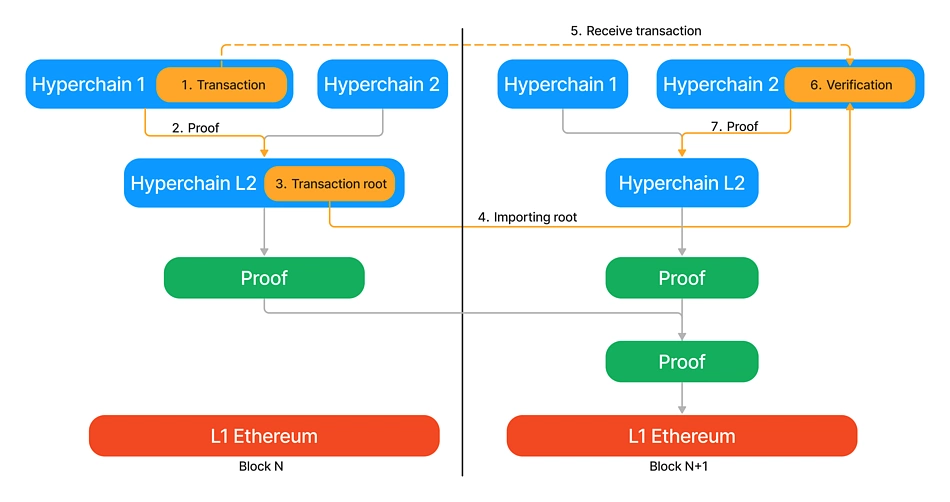What are Layer 3 Blockchains in Crypto?
Layer 3 protocols are built on top of Layer 2s to provide enhanced scalability so developers can create customized application-specific blockchains based on their needs.
Key Takeaways
-
Layer 3 protocols are built on top of Layer 2s to host application-specific decentralized applications.
-
Layer 3s can solve a variety of issues such as scalability, interoperability, customization, and more.
-
Some examples of Layer 3 protocols are Orbs, Arbitrum Orbit, and zkSync Hyperchains.

How Do Layer 1s, Layer 2s, and Layer 3s Work Together?
Layer 1s are blockchains that form the foundation, where blocks are added and transactions are finalized. However, Layer 1s suffer from the blockchain trilemma, where they have to sacrifice either scalability, decentralization, or security. Blockchains like Bitcoin and Ethereum prioritize decentralization and security over scalability, and these networks experience low transaction speeds as network users increase.
This is where Layer 2s, which tackle the scalability issue, come in. Layer 2s are off-chain vertical scaling solutions that run on top of Layer 1s like Ethereum to enable scalability, offering users faster transaction and lower gas fees. They can take the form of rollups or validiums, as in the case of Polygon 2.0. Many Layer 2 solutions, such as Polygon, zkSync, and Arbitrum, have released solutions that enable developers to create app-specific chains built on top of the Layer 2, which brings us to Layer 3s.
Layer 3s are advanced protocols built upon existing Layer 2 solutions, which offer interoperability and application-specific functionalities. This means that Layer 3s are highly customizable and are able to suit a developer's specific needs, such as enabling solutions for targeted issues like privacy, or supporting a high volume of transactions, all while still inheriting the security of the Layer 1 blockchain. Currently, most Layer 3s are built on Ethereum, and there are blockchains, such as Bitcoin, which are not suited to host Layer 3 applications at time of writing.
| Layer 1 | Layer 2 | Layer 3 | |
| Definition | Foundation of the blockchain | Built on top of Layer 1s like Ethereum | Hosts application-specific dApps |
| Primary Role | Secure and run the network |
Reduce Transaction costs and improve the scalability of the Layer 1 |
Highly customizable applications that can solve targeted issues |
| Scalability | Limited scalability | Improved scalability as compared to Layer 1 | Extremely scalable |
| Interoperability | Usually works alone | Able to work with limited chains | Enables different blockchains to work together |
| Transaction Fees | High | Low | Lower depending on the application |
| Use Cases |
Basic blockchain functions |
Advanced transactions with more efficiency | Complex applications that can be used across multiple chains |
| Examples | Bitcoin, Ethereum | Arbitrum, Polygon | Orbs, Arbitrum Orbit, zkSync Hyperchains |
What Problems Do Layer 3s Solve?
Now, with an understanding of how Layer 1s, 2, and 3s work together, let's take a closer look at Layer 3s and how they further scale the blockchain.
Scalability
Designed to enhance scalability beyond the current capabilities of Layer 1s and Layer 2s, Layer 3s are extremely scalable. Therefore, the network would be able to handle a much larger volume of transactions and support a broader range of complex applications at the same time.
Complex dApp Support
Layer 3s are able to provide the necessary infrastructure for the development of more complex decentralized applications that require more advanced features. This could potentially help improve web design to include more advanced features on the application, making it more accessible for layman users. Depending on the developer’s needs, Layer 3s can also facilitate more complex smart contract designs that Layer 1 and Layer 2s could not handle due to limited scalability.
Blockchain Interoperability
Layer 3s also addresses the problem of interoperability. Layer 3s can act as a bridge between the different blockchains so that the transactions and data can flow across the different platforms. This means that the Layer 3 dApps have the functionality to connect to different blockchains such as Ethereum and Solana.
Customization
Layer 3s can also be customized to the unique needs of the developers. For example, developers can introduce application-specific mechanisms that only allow the execution of private transactions and contracts, which would only allow some data to be revealed. Due to the highly customizable functionality of Layer 3s, developers can customize their dApp’s governing mechanism, rules, and functionalities according to their needs.
Arbitrum Orbit allows developers to customize different aspects of their chain. For example, developers are able to customize and choose which tokens to accept for transaction fees on their chain. This gives developers the flexibility to choose and potentially include a native token for the platform, allowing developers to customize the functionality of their dApp to their unique needs. In addition, developers can customize their dApp to ensure users have more consistent and reliable gas prices. Developers can also launch their own blockchain network with specific features – such as Arbitrum’s Nitro-powered blockchain network and Stylus for EVM+ compatibility. Some other customizations that Arbitrum Orbit provides include privacy, permissions, fee tokens, governance, and much more.
Cost-effective
As Layer 3 networks process some of the transactions and operations off-chain, this helps to reduce congestion on the network, which in turn heavily reduces the transaction fees. This cost efficiency helps to reduce the cost barriers to entry, making it much more accessible for developers and users alike.
For example, the Xai network is a dedicated gaming network built to power Web3 games. Built via Arbitrum’s Layer 3 network, the Xai network introduces parallel processing to increase efficiency and scalability while further reducing cost at the same time.
Accessibility
Layer 3s can also be made to be more accessible to the masses, and easier to be implemented. For example, Arbitrum’s Layer 3, Arbitrum Orbit allows anyone to build and deploy their own Layer 3 on Arbitrum Nitro without needing approval. In comparison, launching Layer 2s require a proposal around their trust model and how they will accomplish full decentralization.
Use Cases of Layer 3s
Now that we've looked at what problems Layer 3s solve, here are some possible use cases of Layer 3s:
Gaming Applications
One use case for Layer 3s is blockchain gaming. By operating on Layer 3, it enables the application to function on a dedicated blockchain which allows the transactions to handle a much larger volume of transactions at faster speeds. This is particularly important for gaming applications to help developers maintain a seamless in-game experience for users.
Gaming applications tend to process many microtransactions which can tend to be most costly. As such, operating the application on Layer 3 can allow developers to ensure cost efficiency for users due to the lowered transaction fees of Layer 3s.
Decentralized Finance Applications
Another possible use case for Layer 3 is decentralized finance applications. Operating on Layer 3s is ideal as it enables decentralized finance applications to be customized according to the needs of the application. This means that developers will be able to customize the privacy settings and the different functionalities of the application.
In addition, Layer 3s are extremely scalable, which ensures that the high volume of transactions can be processed quickly which is extremely important for real-time trading. Layer 3s also allows for interoperability among various blockchain networks, allowing users to transfer their assets across the different networks.
Examples of Layer 3s
While the concept of Layer 3s is still considered a relatively new development in crypto, here are some notable projects to look out for:
Orbs
Working in conjunction with existing Layer 1 and Layer 2 protocols, Orbs is a Layer 3 blockchain that focuses on addressing the scalability issues faced by the Ethereum blockchain. According to their website, Orbs view their Layer 3 as an ‘Enhanced Execution’ which allows developers to develop their smart contracts by operating as a decentralized severless cloud.

Source: Orbs
This means that developers are able to write and deploy their smart contracts on Orbs’ own decentralized network and do not have to worry about the network’s underlying infrastructure. This gives developers the convenience of not needing to maintain physical servers as well. Currently, Orbs works with a few Layer 1 and Layer 2 protocols, including Ethereum, BNB Chain, Avalanche, Polygon, and more.
Arbitrum Orbit
In 2023, Arbitrum Foundation also released its new feature – Arbitrum Orbit, which is envisioned as a Layer 3 blockchain built on top of the Arbitrum Nitro platform. Other than even lower transaction costs and enhanced scalability, developers are able to create their own self-managed specialized blockchains on the Arbitrum Nitro platform. This allows the developers to utilize customized blockchains according to their specific needs.
zkSync Hyperchains
Launched by the zkSync team, zkSync Hyperchains can become Layer 3s, which use Layer 2s for settlement. zkSync Hyperchains are powered by the same zkEVM engine available on the ZK Stack, where all ZKP circuits remain identical and inherit the security of the Layer 1, regardless of who deployed them. One benefit is that Layer 3s that settle on the same Layer 2 will have faster messaging between each other and interoperability within the wider ecosystem.

Source: zkSync Era
Final Thoughts
The development of Layer 3s is an interesting innovation in the cryptocurrency space. It improves on what we had before by bringing together the best parts of Layer 1 and Layer 2 — such as making the network more scalable, yet secure. Despite this, it is still good to remember that each of these layers plays a crucial role in the blockchain ecosystem and does not compete against each other. Currently, Layer 3s is still in the stages of development, but I think it is clear that Layer 3s will play a pivotal role in shaping how we will be able to utilize blockchain technology in the future, by making it even easier for blockchains to handle high transaction volumes.

Hwee Yan has been involved in the cryptocurrency space since 2021. Currently pursuing a degree in Linguistics and Multilingual studies at Nanyang Technological University, she is a writer who is mainly interested in NFTs, crypto trends and memecoins. Follow the author on Twitter @cryptohy8









 Or check it out in the app stores
Or check it out in the app stores